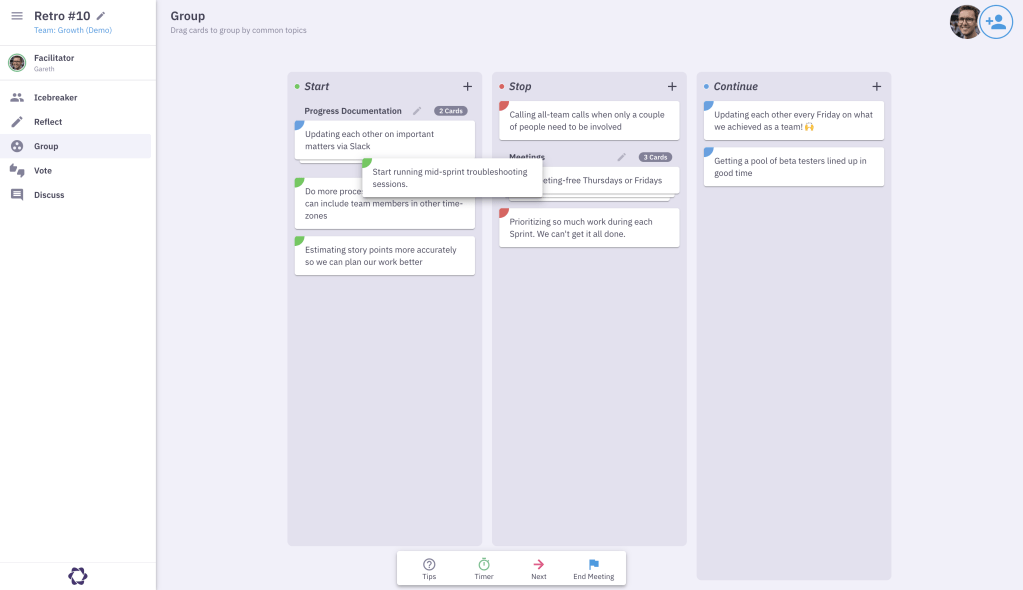How to Run a Pre-Mortem Meeting: Easy 7 Step Process

Imagine this scenario: your team has just completed a project, and it’s been a complete disaster. You missed the deadline, the quality of the work is shoddy, and you’ve wasted a lot of resources, time, and money. You’re not happy, your stakeholders aren’t happy, and neither are your team-mates. You’ve failed.
Now, imagine a different scenario. You’re about to start a project, and you know it has the potential to be a big success. But there are also many unknown variables threatening to derail the project. You want to make sure you’re prepared for every possible thing that could go wrong. So you decide to run a pre-mortem with your team.
By the end of this resource you’ll know the easiest way to run an effective pre-mortem. To transform you into a pre-mortem master, we cover the following topics:
What is a Pre-Mortem?
A pre-mortem meeting is a risk management workshop that’s held before a project begins. During a pre-mortem, your team gets together and imagines a bleak future in which your project has failed. Then you brainstorm all the reasons why that might have happened so you can mitigate any risks.
The goal of a project pre-mortem meeting is to anticipate and prevent possible problems, rather than react to them after they have occurred. It’s an opportunity to identify risks, vulnerabilities, and opportunities so you can address them proactively, reducing your risk of failure.
A pre-mortem is the project management opposite of a project post-mortem, in which you analyze all the reasons something went wrong when it’s already too late to make a difference. The term was first popularized in September 2007 by Harvard Business Review. You might also hear people calling the premortem process a “risk assessment” or “risk analysis” meeting.
How do you run a pre-mortem meeting?
Here’s the easiest way to run a pre-mortem with your team, involving minimal pre-meeting setup, and guaranteed positive results.
1. Set the scene
Before you start the meeting, explain to the team that the goal of the meeting is to imagine that the project has failed and then identify the reasons why that might have happened. You can do this in the meeting invitation.
Make sure that everyone understands that this is not a negative exercise, but rather a proactive one. Encourage team members to think creatively and be open to all ideas. You could also take a moment at the start of your meeting to run a quick icebreaker to open everyone up.
Note: Pre-mortems can be hard to get your head around if you’ve never done one before, so leave space for participants to ask clarifying questions.
2. Choose a structured pre-mortem template
When pre-mortems fail to deliver results, it’s usually because they are unstructured, hard to contribute to, and action items get lost somewhere on a whiteboard never to be seen again. So set yourself up for success with a structured template that’s guaranteed to deliver the goods.
The easiest way to do this is to use a pre-built template or “premortem technique” with prompts your team-mates can respond to. This gives your meeting structure and makes it easier for people to participate.
You can run a pre-mortem meeting for free in Parabol, and choose one of the many pre-built templates to run your meeting.
To start your pre-mortem in Parabol click the button below, navigate to “retrospectives”, and choose one of the pre-mortem templates. Oh, and don’t forget to invite your team to join you!
3. Imagine the failure
Now ask team members to imagine the project has failed. Your team members can respond to the prompts directly in Parabol anonymously or non-anonymously. We recommend giving your team members 6-7 minutes to think through and jot down everything that could go wrong.
Encourage your colleagues to be specific and detailed. Tell them to assume that everything that could go wrong has gone wrong.
4. Review failure reasons out loud
Read out every failure idea your team members have written down. This ensures that everyone has listened to and understood every possible reason your project or sprint could go wrong. In Parabol, everyone’s anonymous (or non-anonymous) comments are revealed to the group.
5. Group failures into themes
After reading out all the contributions, you’ll likely identify some common threads so group them together into themes.
For example, if several team members identify communication breakdowns as a reason for failure, group those reasons together. This will help you identify patterns and common themes.

Take 4-5 minutes to drag and drop similar reflections together into themes. It’s totally okay if there are some reflections that don’t fit into any group.
6. Prioritize topics by voting on them
Once you have identified the reasons for failure, you’ll need to prioritize them. Ask team members to vote on which reasons they think are the most likely to cause the project to fail. This will help you focus your efforts on the most critical areas.
As a facilitator you can ask team members to choose what they vote for based on likelihood of occurrence, the magnitude of the issue, or with both in mind. In Parabol, the facilitator can set how many votes each team member gets.
We recommend giving each team member 6 votes, and suggest voting in a 3-2-1 pattern. So the most important issue to a team member gets a 3, and then a 2, and then a 1.
When everyone has voted and you reveal the outcome, you should have a prioritized agenda of discussion topics!
7. Discuss and develop strategies
After you have identified the most likely reasons for failure, work through them one by one to develop mitigation strategies.
Brainstorm solutions to each of the potential problems that have been identified. Ask team members to suggest strategies for addressing each of the reasons for failure. Parabol includes a discussion thread so you can take note of any important ideas, or drop in thoughts via text if it’s hard to get a word in.
As you work through each theme, remember to set an action plan and takeaway tasks. What are the practical things you will do to prevent failure? With Parabol, you can do this directly in the meeting and export those tasks to your task management tool.
What happens next?
Now you’re armed with some strategies to mitigate project risk, and improve your chances of success. You can follow-up with your team-mates at the end of the project, with a lessons learned meeting, retrospective, or project post-mortem! When you’ve finished your meeting, Parabol will send an automated meeting summary that you can always refer back to.
Here’s a short checklist of things to do after your pre-mortem:
- Make sure every action item is assigned to only one person to create accountability
- Set a date to remind team-mates of action items
- Follow up before you begin your project to check action items have been implemented
Pre-mortem templates
The hardest thing about running a pre-mortem is knowing where to start. But with pre-built templates, you don’t have to worry about getting started.
Here are a few of the most popular pre-mortem templates in Parabol:
Excited and worried pre-mortem
- 🤩 What are you excited about?
- 😨 What are you worried about?
Glass half empty pre-mortem
- ⏳ Glass half full: What do we expect to go well?
- ⌛ Glass half empty: What do we worry will go wrong?
Blind spot pre-mortem
- 👁️ Visible: What threats are clear to see and we should mitigate
- 👻 Invisible: What invisible or unknown threats should we pre-empt
🤔 What if… pre-mortem
- What if [insert]
- What if [insert]
- What if [insert]
How likely to fail pre-mortem
- 💯 Highly likely: What issues are we highly likely to face?
- 🤔 Likely: What issues are we likely to face?
- 🤷 Possible: What issues could we possibly face?
For more pre-mortem templates see our whole resource dedicated to pre-mortem ideas.
Pre-mortem questions for facilitators
Asking good questions may help your team consider things they hadn’t before, or encourage deeper responses. Try asking some of these questions when you reach the discussion phase of your pre-mortem. These questions can help you dig in deeper and get to the root cause of a worry or concern.
- What could go wrong with our project or plan?
- Are there any big risks we haven’t discussed yet but are important?
- What are the key assumptions we have made, and what happens if they are proven wrong?
- What’s the easiest thing we could do to mitigate this risk?
- What could we do to cause our own failure?
- What are the potential blind spots in our plan or approach?
- What are the potential unintended consequences of our actions?
- What could cause delays or other roadblocks to success?
- What could we overlook or underestimate?
- What could go wrong that we haven’t even considered yet?
💡 To see the full list of questions, check out: 40+ Pre-Mortem Questions For Your Next Meeting
When to run a pre-mortem
The best moment to run a pre-mortem exercise is a week or so before your project begins. You need to allow a little time before the project begins so you can implement the actions that come out of your workshop.
1. You’ve had problems in previous projects
When projects have run into roadblocks in the past, you may want to run a pre-mortem workshop as well as an end of project lessons learned meeting.
2. You want to stress test your project plan
If you’ve put together an ambitious or high stakes project plan, a pre-mortem is a good way to give yourself a little more security when it comes to future outcomes.
3. There’s a big one-off event coming up – like a product launch
Product launches are things that only happen once. You can’t turn back the clock and try again. A pre-mortem can help you make the most of your launch and help prevent issues in advance. Then you can follow it up with an after action review.
4. You’re doing something for the first time
Whether it’s working with a new contractor, or using new skills, a pre-mortem can help you set expectations about what success and failure looks like, so you can reduce the risks of it going wrong. For example, at Parabol we run pre-mortems when working with new contractors on projects, so each party can set expectations.
5. When the cost of failure is high
Always run a pre-mortem when the stakes are high, financially or reputationally. For example, you should always run a pre-mortem before a merger or acquisition, during change management processes, or when there would be a negative public relations outcome if your project/action went wrong.
When you’re serious about improving your work, try running your pre-mortem immediately after the end of the previous project – especially if you end your projects with post-mortems, retrospectives, or lessons learned meetings. With previous failures fresh in your mind, it will be easier to come up with good solutions for the future.
What are the benefits of a pre-mortem?
Pre-mortems are an incredibly valuable but generally under-used tool for securing the success of your projects. The top benefits of running a premortem include:
1. Reduce the number of critical issues
Whether it’s running out of budget, over-time, or communication breakdown, a pre-mortem can help you reduce the number of critical issues you face in your projects. That means better project outcomes, happier stakeholders, and less stress all around!
2. Encourage team collaboration
A pre-mortem meeting encourages collaboration and teamwork from the get-go. By giving teams an opportunity to share their thoughts and ideas you end up with more creative solutions. Discussing problems upfront can also help temper overconfidence and create a space to interrogate biases.
3. Create ownership of problems for teams
Oftentimes it’s the project manager or team leads that’s expected to have all the answers and fix the problem when something goes wrong. If your team discusses the issues together upfront in a pre-mortem and builds collective ownership, it becomes more resilient, because the responsibility isn’t on one person’s head.
4. Improve decision-making
A pre-mortem meeting can help you make better decisions. By considering all possible outcomes, you can make more informed decisions about how to proceed with your project.
5. Increase project success
Ultimately, a pre-mortem meeting can increase the success of your project. By identifying potential risks, developing strategies to address them, and improving decision-making, you are setting your project up for success.
Pre-mortem FAQs
Here are some of Parabol’s answers to the most common questions about pre-mortems!
Pre-mortem vs post-mortem: What’s the difference?
Pre-mortem and post-mortem are two different types of meetings that are used in project management and decision-making processes. The main difference between the two is the timing of the meeting.
- Pre-mortems take place before a project or decision is made.
- Post-mortems take place after a project or decision is made.
In a pre-mortem meeting, participants imagine that the project or decision has failed and then work backward to identify the potential causes of failure. In a post-mortem meeting, participants review the project or decision and analyze what worked well, what didn’t work well, and what could be improved for the future after the project or decision failed.
What to say in a pre-mortem meeting?
Facilitators can follow the step-by-step process in this article for guidance on what to say and how to move a team through a pre-mortem workshop. You can also check out our pre-mortem questions bank for inspiration.
As a participant, simply provide as much detail and context as you can for why a thing might go wrong. Here are some pre-mortem examples:
- “Communication breakdown could happen due to time-zone differences between the creative team and the development team”
- “We could spend too much time planning which wouldn’t leave us enough time to complete the project”
- “Our website infrastructure could go down when we launch the new changes, which would cause big problems for our users”
What’s the best way to run a pre-mortem workshop?
Parabol provides a step-by-step structured process for team leads to facilitate a pre-mortem workshop. It includes pre-built templates, optional icebreakers, and powerful facilitation tools like timers, voting options, and a clear way to keep the meeting moving.
It features a suite of integrations so you can integrate your action items directly with your task management tool, and supports synchronous and asynchronous collaboration.
Future-proof your project with a pre-mortem today!
Pre-mortems are a powerful tool for any team starting a new project. By identifying potential risks, developing strategies to address them, and improving decision-making, you can prevent future failures and increase the success of your project.
So, the next time you are about to start a new project, run a pre-mortem meeting with one of Parabol’s ready-made templates! You won’t regret it!






